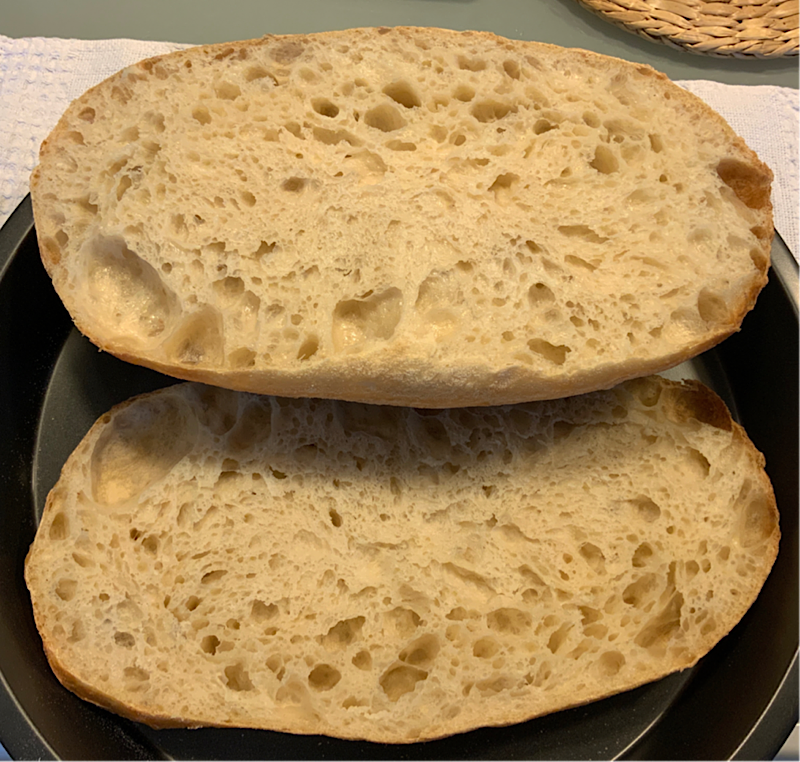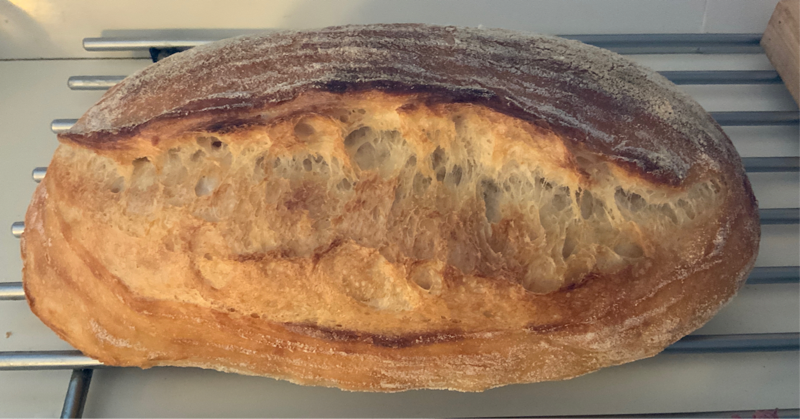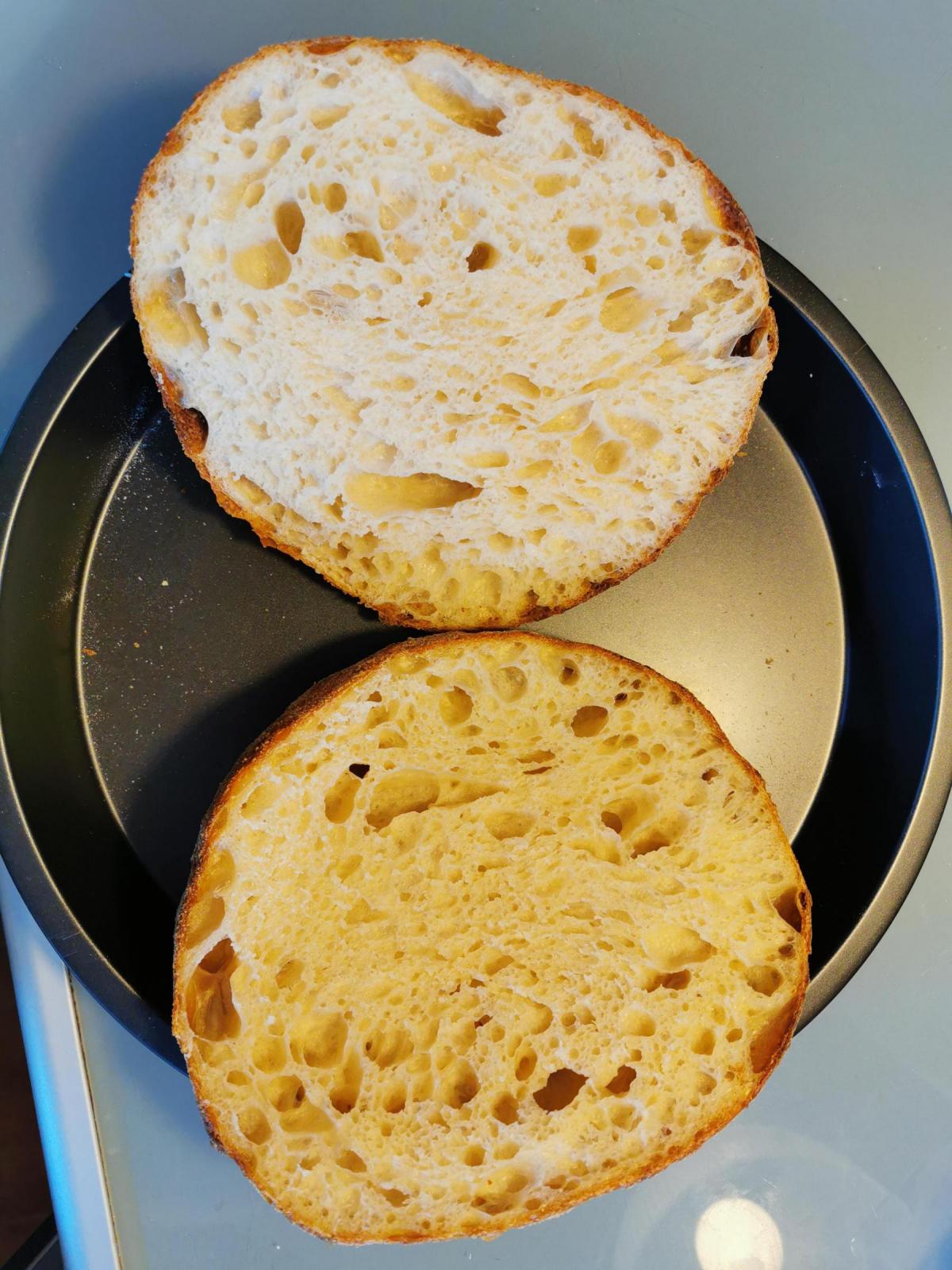Good evening,
First post here (second after my introduction) and I wanted to ask for help from the Community on improving the overall structure of my open-crumb loaves. This is a loaf I baked yesterday:


As you can see from the pictures, the outer parts of the loaf feature a nice (to me) open crumb, while the core of the loaf has a much more compact crumb. This si something recurrent in my loaves (especially round ones). I’ve been thinking of 3 possible culprits:
1) My shaping skills
2) My oven, that is not able to heat fast enough the core of the dough (I get more compact crumb in proportion with boules than I get with these (kind of) batards.
3) Bulk Fermentation: I used the Brod & Taylor foldable proofbox @ 24C- 75F in-between S+Fs.
The recipe is a no-knead 77% hydration with 2 hours autolyse, 3 hours of S+Fs every 45 minutes and final proofing in the fridge. This one was in the fridge for 15 hours and was then out of the fridge into the proof box for another 2 hours before baking.
Flour is reliable, ingredients were measured accurately, starter looks alright to me but I’m not an expert in starters.
Any advice will be appreciated. Thanks in advance.
I think your crumb is very close to being good. Your though about the heat of your oven sound logical. Ne of the indicators that lead me to think heat issues is the thinness of your crust.
Are you using a baking stone?
How long do you preheat your oven?
What temperature are you baking at?
This fix might be a simple one. Your breads is looking good, but can be improved...
Danny
I think Dan's onto something.
Have you checked your oven temp with an oven thermometer or infrared gun?
Thanks Idavendry and Danny for your comments. I’m happy to hear it might be an equipment issue more than a lack of skills :-).
Now that I think of it, the underside of my breads is always whitish and relatively undercooked, so I’m pretty sure you guys are onto something here.
I use a baking stone that is lying on top of 3 terra-cotta bricks (the kind you use in fireplaces or pizza oven hearths), and I have a couple of additional bricks on the base of the oven. My oven is definitely stable in its temperature (lots of thermal inertia, for the technically-inclined) but not necessarily at the right temperature, as you guys point out. I also use a cast-metal skillet that I heat with the oven and I pour water on when I start baking the bread.The baking stone + bricks concoction is middle height in the oven. I preheat the oven for a good hour before baking one loaf and space loaves at least 30 minutes.
I don’t have an oven thermometer here (lockdown, second residence) but my guess is that the oven is 220-225 Celsius tops. I can’t go any higher because then the top heating element of the oven gets into extra heat mode when the temperature is pushed higher (oven feature, go figure), which is good for the lasagnas and the likes but I don’t need to say it browns my loaves much faster than it should in a normal baking process. I therefore can’t push the temperature above those estimated 220-225.
I guess we have an answer here.... Do you guys think that baking in a Dutch oven would help? It would definitely not push temperature above 220 but it might somehow help by at least concentrating the heat? I think my bricks already do that but it doesn’t hurt to ask.... Thanks again.
I would be tempted to try a pre-heated (1hr) cast iron Dutch oven without the stones. bake 20 minutes covered.
If you want you can pre-heat with the top element on. If you think you need it. The dough needs more heat.
I was trying to avoid buying one but I guess all roads lead to a Dutch oven in this case. I have a question, I prefer batards to Boules. What’s the equivalent of a Dutch oven to have a batard? Do oval Dutch ovens exist that allow such a trick? Thanks again.
If you have a pan that is large and tall enough to cover the loaf you could try the baking stone on the bottom and the cover on the top.
NOTE -
Especially for ovens that won’t get super hot, you never want to pour anything other than boiling water into the oven for steam. Cold water will reduce the oven temp. But with a covered pot you will not meed steam.
We used to recommend Graniteware but the price has gone up considerably.THIS looks good to me.
See this article about Cast Iron vs Graniteware (light weight roasters).
Your older post on the GW vs. DO is extremely interesting. Thanks so much for sharing the information.
One boule I baked this evening in case it helps. The core is closed crumb. The rest is good. Thin crust as already mentioned by Danny. Thanks again.
Since you sliced this horizontally, please post an image of the bottom.
Sorry, wrong image. This is the correct boule.
The round one has better crumb. It got more heat, you can tell by the crust.
Thanks Danny. Really appreciated. Before I spend the money on the DO, I have a big IKEA stainless steel bowl that is not too massive (thick). I tried it once (pre heated in the oven, with steam on the pan as well) and lifting the bowl after 20 minutes showed a loaf that had no crust yet, just a yellowish crust-to-be. The scoring had bloomed reasonably. Is this how the loaf should look after 20 minutes under the dome and I was doing the right thing, or did using vapor affect the normal baking process under the dome?
Thanks again, I’m learning a lot with your help. Really thankful.
The thickness of the metal cover doesn’t appear to matter. Actually testing shows that thinner metal gets hotter quicker. Read the link I sent you.
No need to steam bread in a covered vessel. If you weigh your dough before and after baking, you see that the loaf lost lots of weight. This is due to water evaporation. The vapors remain in the cover and keep the loaf humid.
“ my guess is that the oven is 220-225 Celsius tops. I can’t go any higher because then the top heating element of the oven gets into extra heat mode when the temperature is pushed higher (oven feature, go figure), which is good for the lasagnas and the likes but I don’t need to say it browns my loaves much faster than it should in a normal baking process. I therefore can’t push the temperature above those estimated 220-225.”
Preheat as hot as your oven will allow. Including using the top element.
Since you are experimenting with covered baking you may be able to keep the top element on. You may need to lower the shelf if the top gets too hot. You’ll have to experimental!
"Now that I think of it, the underside of my breads is always whitish and relatively undercooked, so I’m pretty sure you guys are onto something here.
I use a baking stone that is lying on top of 3 terra-cotta bricks (the kind you use in fireplaces or pizza oven hearths), and I have a couple of additional bricks on the base of the oven."
THere's your problem. You have too much cold mass directly under the baking stone. 1 hour is not enough to get it all up to temp. Take out the 3 terra cotta bricks, and the bricks on the base of the oven, too, as they are likely absorbing some radiant heat that could otherwise go to the walls of the oven, or even the baking stone.
This is the dead give-away that your baking stone is not heating up properly: "the underside of my breads is always whitish and relatively undercooked"
If you insist on the stones, you'll need to increase your pre-heat towards 2 hours.
I’ll do as you suggest, reduce the thermal mass. I’ve never measured the temperature of the bricks when I start baking, but it makes total sense to me. Indeed the oven will reach the working temperature faster with a lower thermal load.
Next then I’ll remove the bricks, heat, broiler on, for one hour, and bake covered (I’ll probably test broiler-on and broiler-off).
Thanks again to both of you, you’ve been of huge help in debugging this.
Dan's suggestion to use to use "top heat" (what we in the US call the broiler) for Pre-heat only, is your other solution.
Do not use it to cook the bread.
But DO use it for pre-heat.
Pre-heat at 250 C. Let the top element come on. That's perfectly fine for the pre-heat portion.
Then turn the setting DOWN to 220-225 C (so the top element doesnt come on any more.)
Then load your dough in.
If you want to use all those bricks, that's the only way to get them up to 200-220C in an hour.
But frankly, I still think you got too much cold mass keeping your baking stone cool long into the bake.
Steam also cools down the oven temp, as the water absorbs heat in order to turn into steam. More than 1 cup of water is excess. And it should be boiling water, not right out of tap, or else it robs more heat.
--
Net: Ditch the bricks, keep baking stone. pre-heat ( no dough in oven) to 250 C. When 250 C temp is reached (or after 45 minutes, whichever comes later) , turn down oven setting to baking temp, 200/220 whatever, load dough. Prolly don't even need dutch oven or inverted steel bowl. But the inverted steel bowl likely will allow you to avoid using the steam pan.
Hope this helps.
I was thanking you on your previous message but let me do this again here. I’ll do as suggested by you and Dan. Oh man, isn’t bread baking tricky ;-). Stay safe where ever you are.